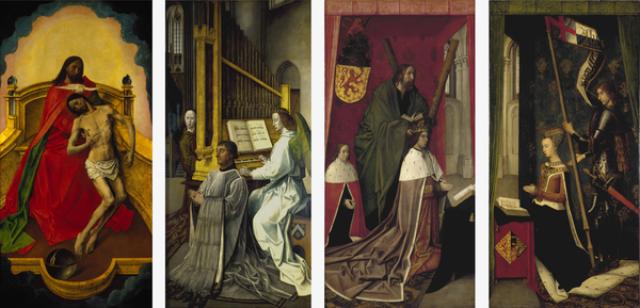Grisaille
A style of monochromatic painting in shades of grey.

A style of monochromatic painting in limited shades, usually of brown or grey onto a mid-toned background. The term is lifted from the French word ‘gris’ meaning ‘gray.’ Popular in the fifteenth and sixteenth centuries, the style emerged as a form of underpainting, allowing artists to build up layers of shadow, highlight and contrast before adding colour in transparent glazes. It was also adopted as a technique for producing complete works of art.
Origins of the Technique
Grisaille has been a popular technique since the Early Renaissance, but it became particularly widespread during the fifteenth and sixteenth centuries in Europe. At the time pigments were scarce, but this technique allowed artists to work with just a small selection of colours to build up tonally rich depictions of space and form that imitated the three-dimensional form of sculpture. Over this solid foundation, glazes of colour could be applied to intensify the realism of the image.
Grisaille was adopted for underpainting frescoes and oil on panel artworks, lending them a rich tonal contrast and a luminous quality of inner light. Some artists made models for engravers with the grisaille technique, sketching out designs from which technicians could work. Grisaille was also developed by Northern European artists as a technique in its own right, particularly as a cheaper alternative for the exterior shutters of polyptychs and large decorative schemes to imitate the effect of low-relief sculpture.
Key Artists
The Proto-Renaissance painter Giotto di Bondone adopted grayscale grisaille techniques to produce the lower panels of his famed Scrovegni Chapel Frescoes - the technique allowed him to create a believable sense of form and volume in his figurative subjects. In Northern Europe, a huge variety of artists including Robert Campin, Hugo van der Goes, Hans Memling, Hieronymus Bosch and Jan van Eyck painted the exterior shutters of winged doors in muted grisaille tones to imitate the voluminous effect of sculpture. These tonally muted doors would have been visible on display most of the time, only being opened to reveal the full colour panels inside on feast days or other special occasions.
Various artists throughout the High Renaissance period in Italy discovered how passages of grisaille underpainting or left bare could allow them to build naturalistic and believable qualities of light falling across figurative subjects and drapery. They include Andrea Mantegna, Andrea del Sarto and in particular Michelangelo, whose passages of grisaille tonal work became an important feature in the Sistine Chapel ceiling. Throughout the seventeenth century grisaille was practiced by Netherlandish artists including Pieter Breughel the Elder, Jan van Goyen and Maerten van Heemskerck, as demonstrated in his pen and ink drawing Job Being Tormented by Satan, 1562.
Later Developments
Throughout modern and contemporary times grisaille has appeared as a technique in its own right rather than a process of underpainting, although the term is less likely to be used in today’s art terminology. Various Surrealist artists worked with monochrome palettes which allowed them to invest greater ambiguity into once familiar subjects, as seen in French painter Rene Magritte’s grisaille on paper work La Gâcheuse (The Bungler) 1935, which was made with a reduced palette on tinted paper. Pablo Picasso also adopted a monochrome, or grisaille palette to create various artworks including his iconic Guernica, 1937. More recently, contemporary artists who have adopted a deliberately grayscale palette include American painter Hugo Bastidas and conceptual artist Rudolf Stingel. Gray has also become an ongoing, defining feature in the work of German artist Gerhard Richter, as seen in Abstraktes Bild (Grau) (Abstract Painting (Grey)), 2002; he writes: '(Gray) has the capacity that no other colour has, to make ’nothing’ visible.'






